Dogs
Going to the Dogs
The 1986 play "Going to the Dogs" is the only play ever to have featured an all-dog cast. You can watch most of it on YouTube, if you can tolerate watching barking dogs. Parts 1-3 below, but there's 7 parts in total.More info: wikipedia

Des Moines Register - Sep 21, 1986
Posted By: Alex - Wed Nov 03, 2021 -
Comments (4)
Category: Theater and Stage, Dogs, 1980s
Pseudo Corpse Scent
The Sigma-Aldrich Corporation sells a variety of scents including: Pseudo Corpse I (that smells like a body less than 30 days old), Pseudo Corpse II (that mimics the dry-rot scent cadavers attain after a month), and Pseudo Drowned Victim.The scents are intended to be used for training rescue dogs, but I suppose they could also be used to enhance a Halloween costume.
Their product literature offers the following info about training dogs to find a corpse:
1 . Enthusiasm - the dog does not hesitate to approach the body. It may attempt to elicit a response from or urinate on the victim.
2. Cautious Interest - the dog slows its search, may become nervous and raise its hackles, but with encouragement, will approach the victim.
3. Avoidance - the dog will not approach the scent source and may actually attempt to leave the area. This behavior may become evident some distance from the body as the dog enters the scent cone.

image source: EliteK9.com
More info: Discover magazine
Posted By: Alex - Sat Jul 24, 2021 -
Comments (3)
Category: Death, Dogs, Perfume and Cologne and Other Scents
Stamp-Licking Animals
Martin Wainwright tells the following story in The "Guardian" Book of April Fool's Day:Like the best April Fool's jokes, this was to girdle the Earth. Not only was the post office besieged by punters wanting to send catlick mail (until the cat was driven demented and fled after two days) but the story spread and resurfaced for years. Animal protection societies weighed in, MPs spoke and the innocuous prank took off. Bone's friend was send clippings from across the country and, as the years went by, from Australia, Shanghai and the United States.
This suggests that stamp-licking animals were a journalistic invention. However, there do seem to have been some real-life examples of the phenomenon.

Longview Daily News - Dec 13, 1974
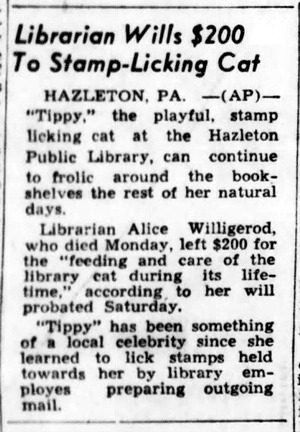
The Bloomington Pantagraph - Mar 11, 1951
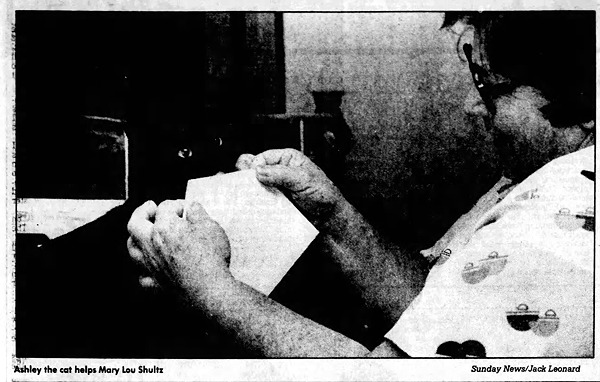
"Ashley practiced stamp-licking until he had the task down purrfectly, then offered to kick off the Organization for Responsible Care of Animals' public appeal... In return for his generosity, each donor will receive a thank-you note enclosed in an Ashley-licked envelope with stamp attached."
Lancaster Sunday News - Oct 6, 1985
Posted By: Alex - Thu Jun 17, 2021 -
Comments (0)
Category: Cats, Dogs, Postal Services, Stamps
Owney, the Taxidermy Post Office Dog
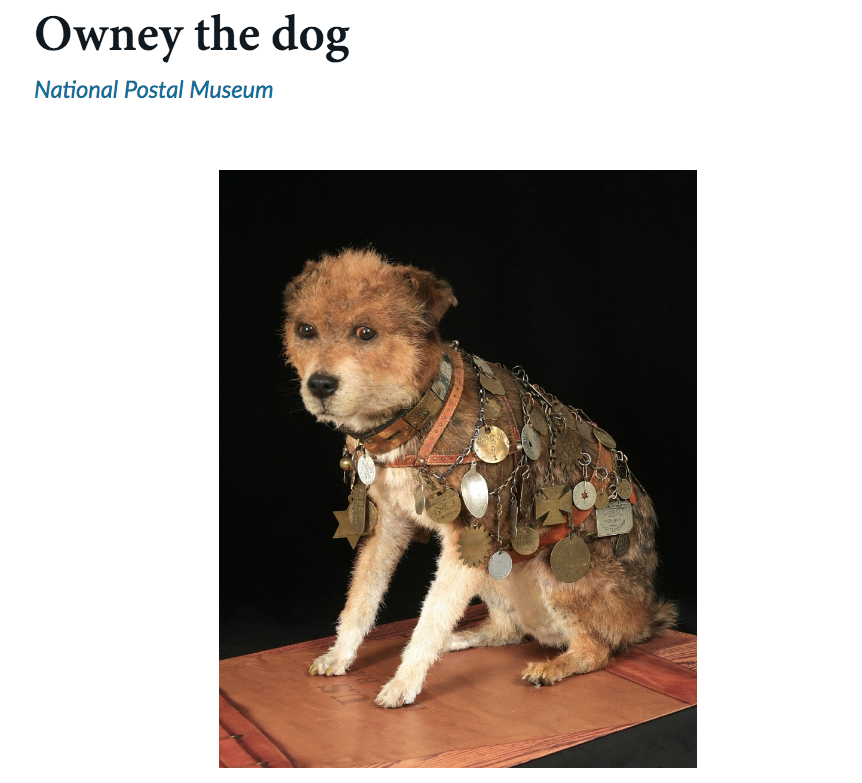
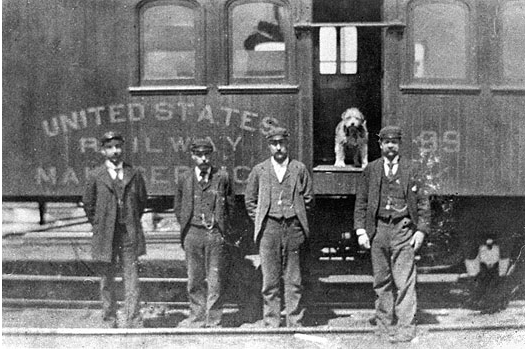
Mail clerks raised money for preserving their mascot and he was taken to the Post Office Department's headquarters in Washington, DC, where he was on placed on display for the public. In 1904 the Department added Owney to their display at the St. Louis, Missouri, World’s Fair. In 1911, the department transferred Owney to the Smithsonian Institution. In 1926, the Institution allowed Owney to travel to the Post Office Department’s exhibit at the Sesquicentennial exhibit in Philadelphia, Pennsylvania. From 1964-1992, he was displayed at the Smithsonian museum now known as the National Museum of American History and in 1993 he moved to the new National Postal Museum, where he remains on display next to a fabricated Railway Post Office train car.
Source.
Posted By: Paul - Wed Apr 28, 2021 -
Comments (0)
Category: Travel, Trains and Other Vehicles on Rails, Dogs, Nineteenth Century, Twentieth Century, Postal Services
Buster Makes Room for His Mama at the Bargain Counter
Actually, it's Tige who deserves all the credit.
Posted By: Paul - Sat Feb 13, 2021 -
Comments (0)
Category: Movies, Shopping, Comics, Children, Dogs, 1900s
Animal psychic clears dog of eating owner
After Dean Goodman crashed his car into a canyon in early 1978, something ate his body. His mother assumed it was his German shepherd, Prince, who had survived the crash and remained at the scene for three weeks until Goodman's body was found. She wanted the dog put down.More details from Skeptical Inquirer magazine (Winter 1978):
Coyotes and wild dogs, the German shepherd said, had eaten the body, despite Prince's valiant efforts to drive them off. The canine hero's life was spared, owing to this timely information. A local police sergeant observed, "She says she got the information from the dog—and I've no evidence to dispute that."

Santa Rosa Press Democrat - Feb 28, 1978
As far as I can tell, Beatrice Lydecker is still active, and still talking with animals. She's got a website where she sells various "natural products," as well as her book: You Too Can Talk With the Animals.


Beatrice Lydecker - 1988 press photo
Posted By: Alex - Mon Jan 04, 2021 -
Comments (4)
Category: Paranormal, Dogs, 1970s
Dog chews ‘How to train your dog’
While browsing old newspapers, I've come across multiple reports of a book titled How to Train Your Dog being returned to libraries, chewed.These reports span thirty years, and specify different locations where this happened, but the stories are otherwise identical. So I figure that the chewed dog training book must be an urban legend of libraries.
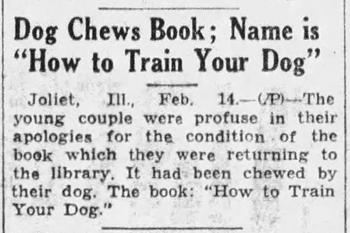
Wausau Daily Herald - Feb 14, 1940

Indianapolis Star - May 24, 1951

Chattanooga Daily Times - Apr 25, 1955

Chambersburg Public Opinion - Mar 13, 1969
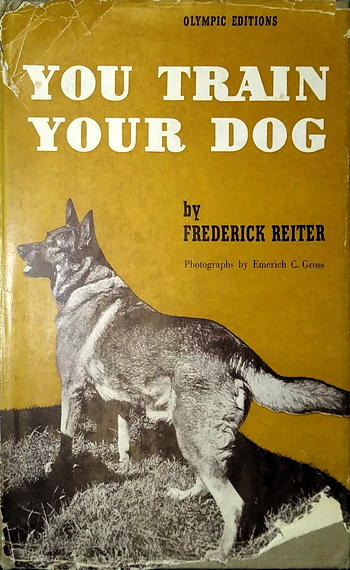
Posted By: Alex - Tue Dec 01, 2020 -
Comments (0)
Category: Books, Libraries, Myths and Fairytales, Dogs
Disease detection toilet using dog
Patent #10,455,817 was granted in Oct 2019 for "animal olfactory detection of disease as control for health metrics collected by medical toilet."In plainer language, it's a toilet that has a small door built into the side of it (the "scent dispenser"), allowing a dog to smell your poop (or other bodily fluids) in order to detect the presence of disease. From the patent:
An animal may be trained to sniff the scent dispenser in response to a command or signal. The user may give the animal the command or signal when the user desires the animal to assess the presence of disease in the user.
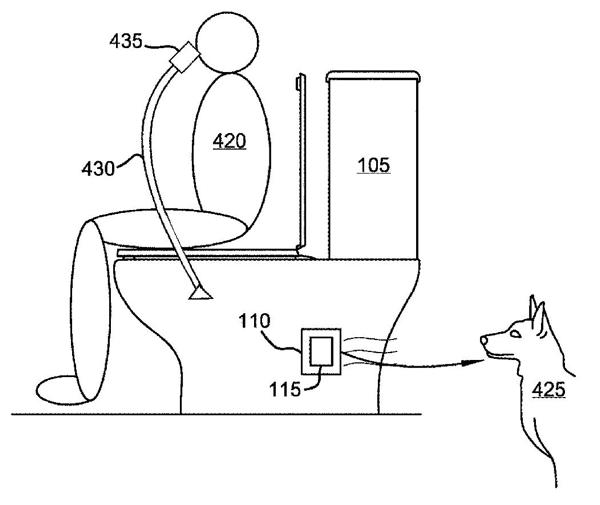
Posted By: Alex - Sun Oct 04, 2020 -
Comments (2)
Category: Bathrooms, Inventions, Patents, Dogs
Follies of the Madmen #487
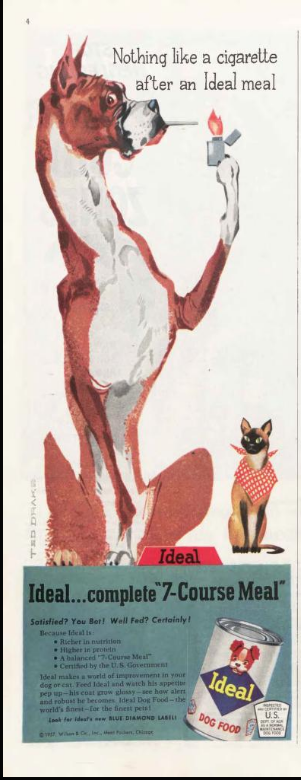
This impossible freakish dog is a true representative of the species, and thus can be a fine judge of the sponsor's food.
Plus, cats are jealous of both dog food and cigarettes.
Ad source.
Posted By: Paul - Sun Sep 06, 2020 -
Comments (1)
Category: Anthropomorphism, Business, Advertising, Food, Cats, Dogs, 1950s
Rescued by Rover
The first film to star a dog.
And the first to pay its actors!
Posted By: Paul - Tue Sep 01, 2020 -
Comments (0)
Category: Movies, World Records, Dogs, 1900s

| Who We Are |
|---|
| Alex Boese Alex is the creator and curator of the Museum of Hoaxes. He's also the author of various weird, non-fiction, science-themed books such as Elephants on Acid and Psychedelic Apes. Paul Di Filippo Paul has been paid to put weird ideas into fictional form for over thirty years, in his career as a noted science fiction writer. He has recently begun blogging on many curious topics with three fellow writers at The Inferior 4+1. Contact Us |




